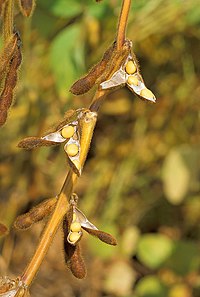
Photo from wikipedia
An experiment was conducted to evaluate the effect of the age of a seedling and sources of nutrients on the growth and yield of sweet corn at SKUAST-K during Kharif-2020.… Click to show full abstract
An experiment was conducted to evaluate the effect of the age of a seedling and sources of nutrients on the growth and yield of sweet corn at SKUAST-K during Kharif-2020. The experiment was performed under a factorial arrangement in a randomized complete block design (RCBD) with three replications. Factor A was the age of the seedling with three levels, viz., 12-day-old seedlings, 22-day-old seedlings, and 32-day-old seedlings. Factor B was the source of nutrients with five levels, viz., control, recommended dose of fertilizer (RDF), 1/2 RDF + 12 t ha–1 farmyard manure, 1/2 RDF + 4 t ha–1 vermicompost, and 1/2 RDF + 2 t ha–1 poultry manure. The experiment was tested using variety Sugar-75 with a spacing of 75 × 20 cm2. The findings of this study indicated that the age of the seedling and sources of nutrients extended a significant influence on growth parameters, yield attributes, and yield of sweet corn. Significantly highest values for various growth parameters of sweet corn, viz., plant height, number of functional leaves, leaf area index (LAI), and dry matter accumulation from 30 days after transplanting up to the harvest, were noted by transplanting A2 seedlings (22 day old). A similar trend was observed for yield attributes and yield with higher values with transplanting A2 seedlings (22 day old). Plots fertilized with 1/2 RDF + 2 t ha–1 poultry manure registered a significantly higher plant height, leaf area index (LAI), dry matter accumulation, and number of functional leaves, which eventually resulted in a higher green cob yield and green fodder yield under the same treatment. Overall, this study indicated that among different ages of seedlings, transplanting A2 seedlings (22 day old) outperformed other seedling ages, and plots treated with 1/2 RDF + 2 t ha–1 poultry manure outperformed other treatments; a combination of both proved superior in realizing a higher yield and profitability with a benefit–cost ratio (BCR) of 6.57 under temperate climatic conditions.
Journal Title: ACS Omega
Year Published: 2023
Link to full text (if available)
Share on Social Media: Sign Up to like & get
recommendations!